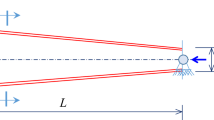Abstract
Bridge girders exposed to aggressive environmental conditions are subject to time-variant changes in resistance. There is therefore a need for evaluation procedures that produce accurate predictions of the load-carrying capacity and reliability of bridge structures to allow rational decisions to be made about repair, rehabilitation and expected life-cycle costs. This study deals with the stability of damaged steel I-beams with web opening subjected to bending loads. A three-dimensional (3D) finite element (FE) model using ABAQUS for the elastic flexural torsional analysis of I-beams has been used to assess the effect of web opening on the lateral buckling moment capacity. Artificial neural network (ANN) approach has been also employed to derive empirical formulae for predicting the lateral-torsional buckling moment capacity of deteriorated steel I-beams with different sizes of rectangular web opening using obtained FE results. It is found out that the proposed formulae can accurately predict residual lateral buckling capacities of doubly-symmetric steel I-beams with rectangular web opening. Hence, the results of this study can be used for better prediction of buckling life of web opening of steel beams by practice engineers.
Similar content being viewed by others
References
Timoshenko S P, Gere J M. Theory of Elastic Stability. 2nd ed. New York: Mc Graw-Hill, 1961
Chen W F, Lui E M. Structural Stability: Theory and Implementation. New York: Elsevier, 1987
Trahair N S. The Behaviour and Design of Steel Structures. London: Chapman and Hall, 1977
Chajes A. Principles of Structural Stability. Englewood cliff, New Jersey: Prentice-Hall Inc, 1974
Trahair N S, Bradford M A, Nethercot D A, Gardner L. The Behaviour and Design of Steel Structures to EC3. 4nd ed. Taylor & Francis, 2008
Kalkan I, Buyukkaragoz A. A numerical and analytical study on distortional buckling of doubly-symmetric steel I-beams. Journal of Constructional Steel Research, 2012, 70: 289–297
Galambos T V. Guide to Stability Design Criteria for Metal Structures. 5nd ed. New York: John Wiley & Sons, 1998
Bradford M A, Wee A. Analysis of buckling tests on beams on seat supports. Journal of Constructional Steel Research, 1994, 28(3): 227–242
Standards Association of Australia. AS 4100 Steel Structures. Sydney, Australia, 1990
British Standards Institution. BS 5950 Part 1: Structural Use of Steelwork in Building. London, United Kingdom, 1990
Zirakian T, Showkati H. Experiments on distortional buckling of Ibeams. Journal of Structural Engineering, 2007, 133(7): 1009–1017
AISC. Specification for structural steel buildings (AISC 360-05). Chicago (IL): American Institute of Steel Construction, March 9, 2005
Sharifi Y, Paik J K. Ultimate strength reliability analysis of corroded steel-box girder bridges. Thin-walled Structures, 2011, 49(1): 157–166
Sharifi Y, Paik J K. Environmental effects on ultimate strength reliability of corroded steel box girder bridges. Structural Longevity, 2010, 18(1): 1–20
Sharifi Y. Reliability of deteriorating steel box-girder bridges under pitting corrosion. Advanced Steel Construction, 2011, 7(3): 220–238
Kulicki J M, Prucz Z, Sorgenfrei D F, Mertz D R. Guidelines for Evaluating Corrosion Effects in Existing Steel Bridges. National Cooperative Highway Research Program Report333: NCHRP, 1990
Kayser J R, Nowak A S. Capacity loss due to corrosion in steelgirder bridges. Journal of Structural Engineering, 1989, 115(6): 1525–1537
Redwood R G, Uenoya M. Critical loads for webs with holes. Journal of the Structural Division, 1979, 105(ST10): 2053–2067
Coull A, Alvarez M C. Effect of openings on lateral buckling of beams. Journal of the Structural Division, 1980, 106(ST12): 2553–2560
Nethercot D A, Kerdal D. Lateral-torsional buckling of castellated beams. Structural Engineering Journal, 1982, 60B(3): 53–61
Kerdal D, Nethercot D A. Failure modes for castellated beams. Journal of Constructional Steel Research, 1984, 4(4): 295–315
Thevendran V, Shanmugam N E. Lateral buckling of narrow rectangular beams containing openings. Computers & Structures, 1992, 43(2): 247–254
Thevendran V, Shanmugam N E. Lateral buckling of doubly symmetric beams containing openings. Journal of Engineering Mechanics, 1991, 117(7): 1427–1441
Shanmugam N E, Thevendran V. Critical loads of thin-walled beams containing web openings. Thin-walled Structures, 1992, 14(4): 291–305
Mohebkhah A. The moment-gradient factor in lateral-torsional buckling on inelastic castellated beams. Journal of Constructional Steel Research, 2004, 60(10): 1481–1494
AISC. Specification for Structural Steel Buildings (AISC 44-48). Chicago (IL): American Institute of Steel Construction, June 22, 2010
ABAQUS User’s Manual, Version 6.9. Pawtucket, RI: Hibbit, Karlsson & Sorenson, 2005
Haykin S. Neural Networks: A Comprehensive Foundation. 2nd ed. New York: Macmillan College Publishing, 1998
Neural Network Toolbox 7 User’s Guide. Mark Hudson Beale Martin T. Hagan Howard B. Demuth, 2010
Rumelhart D, McClelland J. Parallel Distributed Processing. Cambridge, Mass: MIT Press, 1986
Rojas R. Neural Networks-A Systematic Introduction. Springer-Verlag, 1996
Pu Y, Mesbahi E. Application of artificial neural networks to evaluation of ultimate strength of steel panels. Engineering Structures, 2006, 28(8): 1190–1196
Hajela P, Berke L. Neurobiological computational models in structural analysis and design. Computers & Structures, 1991, 41(4): 657–667
Ok D, Pu Y, Incecik A. Artificial neural networks and their application to assessment of ultimate strength of plates with pitting corrosion. Ocean Engineering, 2007, 34(17–18): 2222–2230
Guzelbey I H, Cevik A, Gögüş M T. Prediction of rotation capacity of wide flange beams using neural networks. Journal of Constructional Steel Research, 2006, 62(10): 950–961
Fonseca E T, Vellasco P C G S, Andrade S A L, Vellasco M M B R. da S Vellasco PCG, de Andrade SAL, Vellasco MMBR. Neural network evaluation of steel beam patch load capacity. Advances in Engineering Software, 2003, 34(11–12): 763–772
Author information
Authors and Affiliations
Corresponding author
Rights and permissions
About this article
Cite this article
Sharifi, Y., Tohidi, S. Lateral-torsional buckling capacity assessment of web opening steel girders by artificial neural networks — elastic investigation. Front. Struct. Civ. Eng. 8, 167–177 (2014). https://doi.org/10.1007/s11709-014-0236-z
Received:
Accepted:
Published:
Issue Date:
DOI: https://doi.org/10.1007/s11709-014-0236-z




